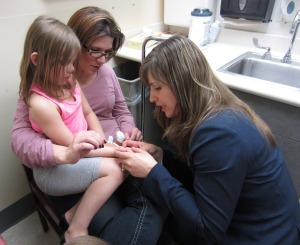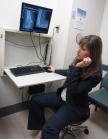Fracture vs. fun: playground injuries
 Like most 6-year-olds, Josephine Schoemer loves to play at the park on the swings, slides and monkey bars. But on Friday, April 26, a fun evening at the park with her dad and sister turned into a trip to the emergency department.
Like most 6-year-olds, Josephine Schoemer loves to play at the park on the swings, slides and monkey bars. But on Friday, April 26, a fun evening at the park with her dad and sister turned into a trip to the emergency department.
Josephine’s mom, Cheyanne, was at work when she got the call. “My husband said she fell forward off the monkey bars and injured her arm, ” she explains, “so I told him to bring her on in.”
In addition to being a mom, Schoemer is an emergency department nurse at Hennepin County Medical Center (HCMC), where children being brought to the ER with playground fractures is nothing unusual. “I just wasn’t expecting to see my daughter in our emergency department.” An x-ray of Josephine’s arm revealed a fractured elbow from the fall.

Dr. Jackie Geissler
“Kids — and adults — naturally try to brace themselves from falls by putting their hands out,” explains orthopaedic surgeon Dr. Jackie Geissler, who specializes in upper extremity injuries. “Falls are one of the leading causes of injury on playgrounds, and those injuries are usually fractures. We see lots of broken elbows, forearms, and wrists from playground falls.”
According to the Centers for Disease Control, emergency departments treat more than 200,000 children ages 14 and younger for playground-related injuries each year in the United States. On public playgrounds, falls from climbing-type equipment account for a majority of the injuries.
“Making sure that the equipment is age-appropriate for your child and well-maintained, and that the surface that children are playing on is safe will help avoid fractures, but there are other dangers as well,” said Dr. Geissler.
“One of the leading causes of death on playgrounds is strangulation,” explains Injury Prevention Specialist Julie Philbrook, RN. “Kids can get tangled on swings and rope-type equipment and actually suffocate.”
Philbrook also offers the following playground safety tips for parents:
- Actively supervise children on playgrounds.
- The area under the equipment should have a shock-absorbing surfaces such as rubber, synthetic turf, sand, pea gravel, wood chips or mulch.
- Teach children that pushing, shoving or crowding while on the playground can be dangerous.
- Use equipment properly — slide feet first, don’t climb outside guardrails, no standing on swings, etc.
- Never use playground equipment that’s wet because moisture makes the surfaces slippery.
These tips apply to home playgrounds as well, where most of the playground-related deaths tend to occur.
While little Josephine is glad to have her cast off so she can enjoy summer activities, she wasn’t too enthusiastic about a return to the monkey bars.
“I’m excited to go swimming,” she said.

